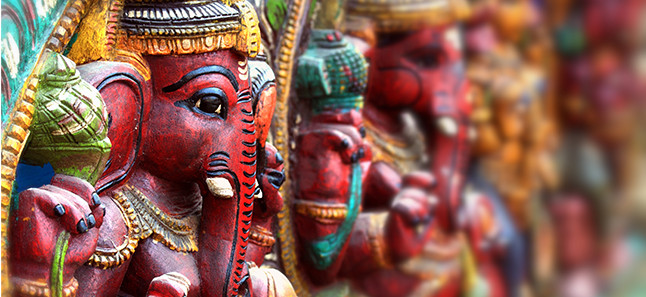
Who is Lord Ganesh?
Ganesha is the formless Divinity - encapsulated in a magnificent form, for the benefit of the devotee. As per Hindu mythology, he is the son of Lord Shiva and Goddess Parvati.
Join a Free workshop on Yoga, Meditation and Breath
The Meaning of Ganesh
Gan means group. A universe is a group of atoms and different energies. This universe would be in chaos if there was no supreme law governing these diverse groups of entities.
The Lord of all these groups of atoms and energies is Ganesha. He is the supreme consciousness that pervades all and brings order to this universe.
Lord Ganesha is
- Achintya – beyond thought
- Avyakta – beyond expression
- Ananta – eternal
The Essence of Lord Ganesha
The essence of Ganesha is brought out beautifully by Adi Shankara.
- Though Ganesha is worshiped as the elephant-headed God, the form (Swaroop) is just to symbolize the qualities of the Divine (parabrahma roopa).
- He is, 'Ajam Nirvikalpam Niraakaaramekam.' This means Ganesha is Ajam (unborn), he is Nirvikalpa (attributeless), he is Niraakaar (formless) and he symbolizes the consciousness which is omnipresent.
- Ganesha is the same energy that is the reason for this universe. It is the energy from which everything manifests and into which everything will dissolve.
The Story of Lord Ganesha's Birth.
We are all familiar with the story of how Ganesha became the elephant-headed God.
As the story goes, Parvati became dirty when she was celebrating with Shiva. When she realized this, she removed the dirt from her body and created a boy out of it. She then asked the boy to keep guard while she bathed.
When Shiva returned, the boy did not recognize him and obstructed his path. Shiva in rage, chopped off the boy's head and entered. At seeing this, Parvati was shocked. She explained to Shiva that the boy was their son and pleaded with Shiva to save him.
Shiva then instructed his helpers to go and get the head of someone who was sleeping with their head pointing towards the north. The helpers got the head of an elephant, which Shiva affixed to the boy's torso and Ganesha was born!
Feeling fearful in the current times is natural. Our breath and emotions are deeply connected. Learn to breathe right and overcome your fears.
Sign up>> for The Art of Living Online Meditation & Breath Workshop.
Facts to ponder upon in Lord Ganesha's story.
Why should Parvati have dirt on her body?
Parvati is symbolic of festive energy. Her becoming dirty signifies that celebration can easily become Rajasik or feverish, and can take you away from your center. Dirt is symbolic of ignorance, and Shiva is symbolic of innocence, peace, and knowledge.Was Shiva, the epitome of peace, so short-tempered that he cut off the head of his own son?
When Ganesha obstructs the path of Shiva, this means that ignorance, which is an attribute of the head, does not recognize knowledge. Then knowledge has to overcome ignorance. This is the symbolism behind Shiva chopping off the boy's head.- Why does Lord Ganesha have ahead of an Elephant?
The elephant is endowed with unusual qualities, like its fearless and its royal walk. It proudly destroys any obstacle on its path. An elephant is also a symbol of authority, endurance, strength, and courage. So, to symbolize these qualities of the Divine, Lord Ganesha is depicted in the form of an elephant. And when we worship Lord Ganesha, we are able to imbibe all these qualities into our consciousness.
The elephant is the only being that can perform all its functions with its trunk. It smells, eats, drinks bathes, and works with its trunk. The trunk is symbolic of the perfect balance between Gyaan Shakti (knowledge) and Karma Shakti (action).
Symbolism and Significance of Ganesha
- Ganesha's big belly represents generosity and total acceptance.
- Ganesha's upraised hand depicts protection. It means, 'Fear not, I am with you, and his lowered hand depicts his giving, as well as an invitation to bow down. This is also symbolic of the fact that we will all dissolve into the Earth one day.
- Ganesha also has a single tusk which signifies one-pointedness.
- He carries in his hands the 'Ankusa' (signifying awakening) and the 'Paasa' (signifying control). With spiritual awakening, a lot of energy is released, which without proper control, can go haywire.
- Ganesha, the elephant-headed God travels on something as small as a mouse? Isn't that so incongruous? Again there is symbolism here that runs deep. The mouse snips and nibbles away at ropes that bind. The mouse is like the mantra which can cut through sheaths and sheaths of ignorance, leading to the ultimate knowledge represented by Ganesha!
Our ancient Rishis were so deeply intelligent that they chose to express Divinity in terms of symbols rather than words since words change over time, but symbols remain unchanged.
Let us keep the deep symbolism in mind as we experience the omnipresent in the form of the elephant God, yet be fully aware that Ganesha is very much within us. This is the wisdom we should carry as we celebrate Ganesh Chaturti.
Featured reading:
Unlock Nataraja & Chidambara Rahasya
Significance & Symbolism of Shiva Linga| Trishul (Trident)| Damru | Third Eye | Shiv Tandav
The symbolism behind the story of the birth of Lord Krishna























